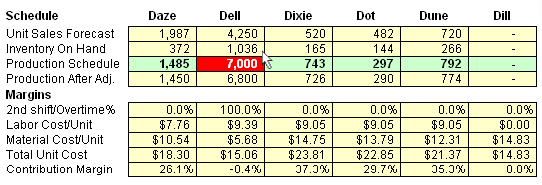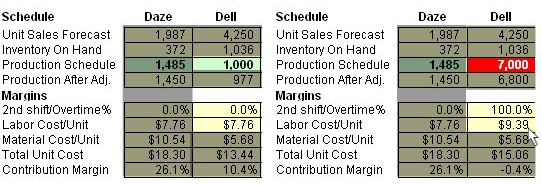The production department's manufacturing schedules are extremely important. If schedules are too low, not enough products are produced and the company will miss sales opportunities. If schedules are too high, inventory will build as excess products go unsold.
The production department must coordinate with the marketing department, matching schedules to forecast.
Schedules should adjust for inventory.
Adding inventory and production after adjustment, which subtracts material shortfalls, breakage and other factors from the production schedule, will give the production department the exact number of products available for sale.

People are needed to manufacture the products, so production decisions affect the labor cost of each unit. Each product line has a 1st Shift capacity, that is, the number of products that can be produced each year with a single 8-hour shift.
When schedules are less than or equal to the 1st Shift capacity, a 2nd Shift is not needed. However, when schedules exceed the first shift capacity, a 2nd Shift is hired.
Wages for 2nd Shift workers are 150% of 1st Shift wages.
Increasing 1st shift capacity for your production lines can reduce 2nd shift labor costs, but it can be an expensive investment.

Increasing automation on a line is a good alternative to 1st Shift capacity increases. Each additional point of automation reduces 1st and 2nd Shift labor costs by approximately 10%.
However, increases in automation can be expensive.
Further, when automation for a product increases, R&D projects for that product take longer to complete. This is because highly automated lines have many more processes to re-engineer. Increases in capacity and changes in automation require one year to implement: Buy it this year, use it next year.

The production department can also sell some or all of a product line's plant capacity. Capacity is sold at 65% of the purchase price. The money is immediately available. This very generous scrap-rate means teams are not penalized for closing down a line to reconfigure the company.
Selling all of a line's plant capacity terminates the product. When products are discontinued, any remaining inventory is sold to scrappers at 50% of the cost of production.
The production department must purchase capacity and automation for any new products. Remember, capacity and automation will not be available until the round following their purchase.
